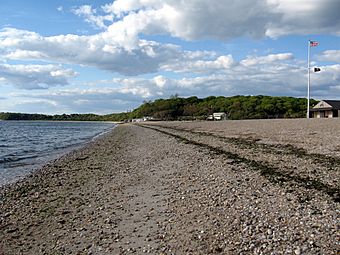West Meadow Beach Historic District facts for kids
Quick facts for kids |
|
|
West Meadow Beach Historic District
|
|

The shoreline of the West Meadow Beach Historic District, with a few cottages
|
|
| Nearest city | Stony Brook, New York |
|---|---|
| Architectural style | Bungalow/Craftsman |
| NRHP reference No. | 04001195 |
| Added to NRHP | October 28, 2004 |
The West Meadow Beach Historic District is a beautiful area in Stony Brook, New York. It is a long piece of land, about 1.5 miles, that sticks out into the water. This land is a public park and also a special historic district. This means it is recognized for its important past.
For most of the 1900s, there were about 120 summer cottages here. These small houses were built along West Meadow Beach on Long Island Sound. Many were built in the 1920s and 1930s. Some were even older, and a few were rebuilt later. People built them on land they leased, often as political favors.
In 1979, a state court decided that these cottages were not allowed. This was because the land they were on was public parkland. Most of the cottages were removed in 2004. Only four were kept. These four are now being used for public activities.
Contents
History of West Meadow Beach
In the early 1900s, people leased plots of land along the beach. They built summer cottages there. Many families came back to their cottages every year for decades. It was a popular spot for summer fun.
In 1976, the local government decided to make the whole area a town park. For a long time, some people had complained about private cottages on public land. Even though the beach itself was open to everyone, some areas near the road had these seasonal cottages. The main part of the beach had lifeguards in the summer. There was also a small building with restrooms for the public.
In 1979, a court ruled that the private cottages were illegally built on public parkland. This caused many years of discussion. Local people wanted the cottages moved off the parkland.
In 1996, a new law was passed. It allowed cottage owners to stay for eight more years. In return, the town could use their rent money to help remove the cottages later. The cottage owners agreed to give up their ownership of the cottages. The money collected from their leases helped pay for removing the cottages and building a new park. This money also helped protect the natural environment, like the salt marsh. It also helped teach people about this important coastal area.
Some people who leased cottages wanted the area to become a historic district. They hoped this would stop the cottages from being removed. On October 28, 2004, the area was added to the National Register of Historic Places. At that time, 92 cottages were still there. They were seen as examples of how people used to live by the beach. However, the court's order to remove them still had to be followed.
In December 2004, the remaining cottages were removed. The process of restoring the beach began. Four cottages were saved to be used for public purposes. Three of them are used by the town's park, safety, and environmental departments. They help protect the park and teach people about nature.
The most historic building is the Gamecock Cottage. It was built around 1876 and has a Victorian style. It is located at the southern tip of the area, called Shipman's Point. The town government is restoring this cottage. A local group, the Three Village Community Trust, will help take care of it.
Public parking is available near the main beach area. This area is also known as the Joel L. Lefkowitz Park at West Meadow Beach. Town residents can park for free. Non-residents can pay a daily fee during the beach season. There is also a small center on the marsh side for viewing wildlife and programs.
West Meadow Beach Wildlife
West Meadow Beach is home to many animals. It has a mile-long beach, a forest, and 88 acres of tidal salt marshes. These areas are part of the West Meadow Wetlands Reserve. This reserve is a safe home for many shore birds and songbirds. This includes endangered birds like the piping plover and least tern. You can also see egrets, black-crowned night herons, and osprey.
This area is recognized as an important habitat for fish and wildlife in New York State. In 2006, a plan was started to guide the restoration of West Meadow Beach.
Songbirds of West Meadow Beach
Many types of songbirds live in the bushy areas along the creek. Some of them include:
- Chipping Sparrows and Song Sparrows
- Yellow, Blue Winged and Prairie Warblers
- House and Carolina Wrens
- Yellow and Black Billed Cuckoos
- Brown Thrashers, Mockingbirds and Grey Catbirds
- House and Gold Finches
- Downy and Red Bellied Woodpeckers
- Baltimore Orioles
- Cedar Waxwings and Eastern Kingbird
The park has a mix of saltwater marsh, beach, and the Long Island Sound. This makes it a great place for wildlife photographers. In the spring, the edges of the beach are full of mating horseshoe crabs. These are very old creatures.
The Pavilion is a building where environmental programs are held. It is on the marsh side. A park ranger and educator lead programs for kids and adults. These include moonlight walks and seasonal programs to see migrating birds. Boy Scouts can even earn environmental badges here. Since 2009, local high school students have built three chimney swift towers and three bat houses in the park. These help attract important animals that eat mosquitoes and need more places to live.
In 2011, the town worked to remove an invasive plant called perennial pepperweed from the beach.
Images for kids




